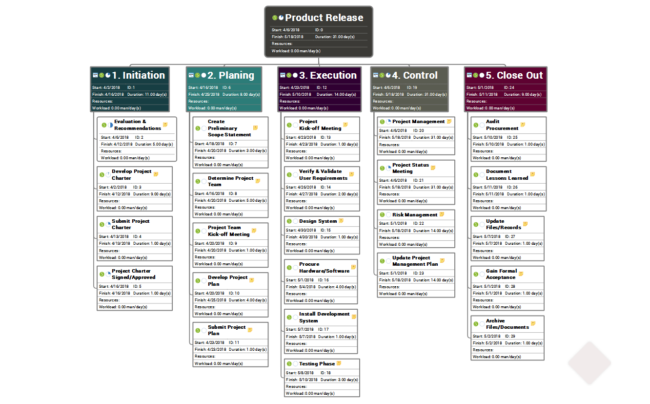Project management tools have played a pivotal part in shaping the way projects are planned, executed, managed, and evaluated in various industries. From the construction of the Pyramids of Giza to the modern-day construction of skyscrapers and infrastructure projects, the need for efficient project management tools has been paramount. With every day, projects are becoming more comprehensive and interconnected, and the role of the project management tools has never been more critical.
The evolution of project management tools can be traced back to the early days of project management, where simple pen and paper methods were used to track tasks, people responsible for them, and their progress. The development of the Gantt chart revolutionized project management by providing a visual representation of project tasks and their dependencies. This laid the foundation for more advanced project management methods, such as the Critical Path Method and the Work Breakdown Structure.
The rise of digital project management tools in the latter half of the 20th century marked a significant milestone in project management evolution. By introducing spreadsheets and computers, project managers were able to automate many of the manual tasks involved in project management, leading to improved efficiency and productivity. With computers becoming more available to businesses in the 70s and 80s, project management software companies began to emerge, offering advanced software solutions for project planning, scheduling, and resource management. This paved the way for the modern project management software solutions that we have today, which offers a wide range of features and capabilities to meet the diverse needs of the project teams.
But let’s start from the beginning and see the development of project management tools throughout the centuries, and how these tools contributed towards more efficient project management, from the first major projects, up to today.
Early Project Management Methods
The roots of project management stretch back to ancient civilizations. While we admire the genius behind the Great Wall of China and the Pyramids of Giza, it is essential to recognize that these monumental projects were managed by using the first project management tools and methods. These early days of project management were characterized by simple, yet effective methods that laid the foundation for modern project management practices. While we are still not fully familiar with the tools and techniques used in these ancient projects, meticulous planning and organization were required to coordinate the efforts of thousands of workers over several decades.

As project management evolved, the use of pen and paper became a common method for tracking and documenting resources and tasks. The job of the project managers was to create detailed plans schedules by hand, while they often used charts and diagrams to visualize project timelines and dependencies. This method was effective for managing smaller projects; however, it became increasingly hard and inefficient as projects grew in size and complexity.
Gantt Chart
The development of the Gantt chart in 1917 by Henry Gantt, an American engineer and management consultant, revolutionized project management. It provided a visual representation of project tasks and resources, and their dependencies. This allowed project managers to easily track progress and identify critical path activities.
The first major project where the Gantt chart was able to fully show its potential was the construction of the Hoover Dam in the 1930s, where it proved to be instrumental in managing the project’s tight schedule and project logistics. By using the chart to track the progress of various tasks, project managers ensured that work was completed on time and in the correct sequence. This helped in securing the successful completion of one of the largest and most challenging construction projects at the time.
One of the key benefits of the Gantt chart is its ability to manage large projects, while it is simple and easy to use. It allows project managers to quickly and easily see the overall project schedule, as well as the individual tasks that make up that schedule. This makes it much easier to identify potential bottlenecks or delays and address them.

Critical Path Method and Work Breakdown Structure
In addition to the Gantt chart, other early project management methods included the Critical Path Method (CPM) and Work Breakdown Structure (WBS), which were developed in the 50s and the 60s.
The Critical Path Method is a project management technique used to determine the longest sequence of dependent tasks and ensure that the project is completed on time. It has become a widely used tool in project management due to its effectiveness in identifying critical tasks and optimizing project schedules.
The history of CPM dates back to the late 1950s, when it was developed by James Kelly Jr. And Morgan Walker, DuPont employees. It was initially used to manage large-scale construction projects, such as the maintenance of the chemical plants within the company. Since then, CPM has been widely adopted in various industries, including engineering, construction, and manufacturing, due to its effectiveness in optimizing project schedules and improving project management efficiency.
One of the key benefits of the Critical Path Method is its ability to identify the critical path of a project. The critical path is the task sequence that determines the project’s shortest possible duration. By identifying the critical path, project managers can focus their efforts on the most important tasks and ensure that they are completed on time. CPM also helps project managers to identify non-critical tasks that can be delayed without affecting the overall project schedule. This allows for more efficient resource allocation and scheduling, leading to cost savings and improved project efficiency.
The Work Breakdown Structure is a hierarchical decomposition of the total scope of work to be carried out by a project team. It breaks down the project into smaller, more manageable components, allowing for easier planning, monitoring, and control. It helps project managers to organize and structure the project’s deliverables and tasks.

The WBS was first developed as part of the Polaris missile project by the UD Department of Defense. The technique was later refined and popularized in the aerospace industry, where it was used to manage complex projects, including the Apollo moon landing program. Since then, the WBS has become a standard tool in project management, used across many industries to effectively plan and execute projects of all sizes.
With the Work Breakdown Structure, project managers can provide a clear and structured overview of the project scope. By breaking down the project into smaller components, project managers can better understand the scope of work and ensure that all necessary tasks are accounted for. This helps in preventing scope creep and ensures that the project stays on track. It also improves communication and collaboration within the project team, by providing a visual representation of the project’s structure, making it easy for team members to see how their work fits into the overall project.
Challenges
The pen-and-paper project management tools laid the groundwork for the sophisticated solutions we have today. However, they came with their own set of challenges:
1. Limited Scalability – the early project management methods struggled with scalability, due to:
a. Project complexity – as projects grew in size and complexity, managing them using handwritten records became non-practical. Projects required more and more intricate planning, but the tools available at the time could not handle such monumental endeavors.
b. Resource allocation – allocating resources, whether labor, materials, or time, became increasingly challenging. Without digital tools, project managers relied on their memory, physical documents (which had to be stationed in one location), and verbal communication, leading to inefficiency.
2. Inefficiency in collaboration – communication between project teams was hindered by several factors:
a. Communication gaps – these project management methods lacked real-time communication channels. Project stakeholders often worked in isolation, leading to delays, misunderstandings, and missed opportunities.
b. Geographical constraints – large-scale projects involved dispersed teams. It was difficult to coordinate efforts across different locations without efficient collaboration tools.
3. Data management and storage issues – early project management tools faced significant data-related challenges:
a. Manual documentation – project details, milestones, and progress were painstakingly recorded by hand. This manual process was prone to errors, and finding specific information required reviewing through many stacks of paper.
b. Storage limitations – physical storage has finite capacity. As projects accumulated data, managing archives became increasingly problematic, adding to that the risk of losing critical information due to fires, pests, or deterioration.
c. Lack of historical insights – without systematic data analysis, project managers could not learn from past experiences. Lessons that were supposed to be learned were not easily accessible, which hindered continuous improvement.
Transition to Digital Tools
The transition to digital tools in project management has revolutionized the way projects are planned, managed, executed, and evaluated. One of the earliest digital project management tools was the spreadsheet, which provided a more efficient way to organize and track project data, compared to pen and paper methods. Spreadsheets allowed project managers to create detailed project plans, track progress, and analyze data more effectively, leading to improved project outcomes.
The rapid evolution of computers in the 70s and 80s, along with them being more readily available for businesses, further accelerated the adoption of digital project management tools. During this time, some of the biggest project management software companies, such as Oracle, Artemis, and Scitor Corporation emerged, offering advanced software solutions for project planning, scheduling, and resource management. These software solutions provided project managers with the tools they needed to manage projects more efficiently, leading to increased productivity and cost savings.
This transition had a profound impact on the industry, enabling project managers to streamline processes, improve communication and collaboration, and make more informed decisions. As technology continues to evolve, project management tools are becoming even more sophisticated, further enhancing the efficiency and effectiveness of project management practices.
Early Project Management Software
In the early days of project management, when pen-and-paper methods reigned supreme, the transition to digital tools marked a significant leap forward. Let’s explore the advantages that digital project management software brought over traditional approaches:
1. Improved Efficiency and Productivity
a. Streamlined Workflows – digital tools automated repetitive tasks, freeing project managers from manual labor. They boosted efficiency through:
i. Task Tracking: Instead of flipping through paper documents, project managers could now track tasks, milestones, and deadlines digitally. Spreadsheets and databases allowed real-time updates and instant visibility into project progress.
ii. Resource Allocation: Digital tools facilitated resource allocation. Whether it was assigning personnel, managing budgets, or scheduling equipment usage, project managers could optimize resource utilization with greater precision.
b. Automated Calculations
i. Gantt Charts: Drawing Gantt charts by hand was a thing of the past. Software generated these visual timelines automatically, factoring in task dependencies and critical paths. Adjustments were made with a few clicks, instead of erasers.
ii. Critical Path Analysis: Digital tools calculated critical paths, identifying the sequence of tasks that determined project duration. Project managers could focus on high-impact activities rather than manual calculations.
2. Enhanced Communication and Collaboration
a. Real-Time Updates
i. Collaboration Platforms: Digital project management software allowed team members to collaborate seamlessly. Whether they were in the same office or on different continents, real-time updates kept everyone informed.
ii. Notifications and Alerts: Automated notifications remind team members of upcoming tasks, deadlines, and milestones. Communication gaps were minimized, leading to smoother project execution.
b. Document Sharing and Version Control
i. Centralized Repositories: Documents, drawings, and specifications were stored in centralized repositories. Team members accessed the latest versions, reducing confusion caused by outdated information.
ii. Version History: Digital tools maintained their histories. If changes were made, project managers could trace back to previous iterations, ensuring transparency and accountability.
3. Better Data Organization and Accessibility
a. Data Retrieval Made Easy
i. Search Functionality: Instead of going through stacks of paper, project managers used search bars to find specific information. Whether it was a budget figure or a risk assessment report, data retrieval became fast and efficient.
ii. Archiving and Retrieval: Digital storage eliminated physical limitations. Project archives were accessible at the click of a button, preserving institutional knowledge for future projects.
b. Data-Driven Decision-Making
i.Analytics and Reporting: Digital tools generated reports, dashboards, and visualizations. Project managers analyzed data trends, identified bottlenecks, and made informed decisions. Historical data informed future strategies.

Early project management software bridged the analog-digital divide, revolutionizing how projects were planned, executed, and monitored. The advantages: improved efficiency, enhanced collaboration, and organized data paved the way for the sophisticated tools we rely on today.
Modern Project Management Software
Modern project management software has evolved significantly in recent years, driven by the rise of the Internet era and the increasing demand for more sophisticated tools. This next generation of project management software has seen the emergence of new key players in the market, as well as the adaptation of existing players to meet the changing needs of project managers and teams.
One of the leading examples of modern project management software is Primavera P6. Developed by Oracle, Primavera P6 is a comprehensive project management tool that offers a wide range of features and capabilities. It allows project managers to plan, schedule, and track projects of any size or complexity, making it an ideal choice for large-scale projects in industries such as construction, engineering, and manufacturing.
Another popular project management software is Microsoft Project. As part of the Microsoft Office suite, Microsoft Project offers integration with other Microsoft applications, such as Excel and Outlook, making it easy for project managers to collaborate and share information with team members. Microsoft Project also offers a range of features for project planning, scheduling, and resource management, making it a versatile tool for project managers in various industries.
ScheduleReader is another example of modern project management software that is gaining popularity among project managers. ScheduleReader offers a unique approach to project management by allowing users to view and analyze XER and XML project schedules created in Oracle Primavera P6. Project managers can have quick access to view schedule data, create reports or perform analysis.
Modern project management software has transformed the way projects are planned, executed, and managed. With a wide range of features and capabilities, these tools help project managers and teams to work more efficiently, collaborate more effectively, and achieve greater project success.
The Project Management Tools of the Future
The emergence of cloud solutions has had a transformative impact on project management tools, paving the way for more flexible, collaborative, and accessible project management solutions. Cloud-based project management tools allow users to access project data from any device with an internet connection, making it easier for teams to collaborate and work together regardless of their location.
One of the key benefits of cloud-based project management tools is their scalability. Cloud solutions can easily scale to meet the needs of projects of all sizes, from small, local projects to large, global initiatives. This scalability allows project managers to adapt their tools to the specific needs of their projects, ensuring that they have the right tools for the job.
Another benefit of cloud-based project management tools is their cost-effectiveness. Cloud solutions typically operate on a subscription-based model, which means that companies only pay for the resources they use. This can result in significant cost savings compared to traditional, on-premises project management solutions, which often require large upfront investments in hardware and software.
Cloud solutions also offer improved security and data protection. Cloud providers invest heavily in security measures to protect their customers’ data, including encryption, firewalls, and regular security audits. This level of security can provide peace of mind to project managers and teams, knowing that their project data is safe and secure.

Overall, the development of cloud-based project management tools is likely to continue in the future, driven by the increasing demand for flexible, collaborative, and cost-effective project management solutions. As technology continues to evolve, we can expect to see even more innovative and advanced cloud-based project management tools that further enhance the way projects are planned, executed, and managed.
Choosing the Right Project Management Tool
Selecting the best project management tool for your business is a critical decision that can significantly impact project success. Let’s go over the key factors to consider when making this choice:
- Size and Complexity of Projects
- Project Scope: Consider the scale and complexity of your projects. Are they small, short-term endeavors or large, multifaceted initiatives? Choose a tool that aligns with your project size.
- Features Needed: Some tools excel at handling intricate dependencies, resource allocation, and critical paths. Others are lighter and more suitable for simpler projects. Assess your requirements carefully.
- Team Size and Structure
- Team Collaboration: Evaluate how your team collaborates. Do you have a small, tightly-knit team or a distributed workforce? Look for tools that facilitate seamless communication, document sharing, and task assignment.
- User Licenses: Consider the number of team members who will use the tool. Some tools charge per user, while others offer flat rates. Go for scalability to accommodate future team growth.
- Budget and Cost Considerations
- Cost Analysis: Project management tools vary widely in pricing. Some are free or open-source, while others require a subscription. Weigh the features against the cost. Remember that investing in the right tool can yield long-term benefits.
- Hidden Costs: Look beyond the initial price. Consider training, support, and any additional integrations you might need. Factor in the total cost of ownership.
- Trial Periods and Demos Available
- Trial Versions: Most reputable tools offer trial versions. Take advantage of these to explore the interface, features, and usability. Involve your team in the testing process.
- Demos and Webinars: Attend vendor demos and webinars. These sessions provide insights into the tool’s capabilities and allow you to ask questions.
- User Reviews and Recommendations
- User Feedback: Read reviews and testimonials from other organizations. Platforms like Capterra, G2, and TrustRadius provide valuable insights. Pay attention to both positive and negative feedback.
- Industry Peers: Seek recommendations from colleagues in your industry. They may have firsthand experience with specific tools and can share valuable insights.
- Customization and Integration Capabilities
- Customization: Consider whether the tool allows customization to match your workflow. Can you tailor fields, templates, and dashboards to your specific needs?
- Integration: Assess integration capabilities. Does the tool integrate with other software you use (e.g., CRM, accounting, or communication tools)? Seamless data flow enhances efficiency.
Choosing the right project management tool involves a holistic assessment of your unique needs. Balance features, costs, and user experiences to find the tool that empowers your team and drives successful project outcomes.
Effective Project Management in the Past, Present, and Future
The evolution of project management tools from pen and paper to modern software has been driven by the need for increased efficiency, collaboration, and adaptability in managing projects. The early methods of project management laid the foundation for modern techniques, such as the Gantt chart, Critical Path Method, and Work Breakdown Structure, which have become essential tools in project management.
The transition to digital tools in project management has further enhanced the way projects are planned and executed. The emergence of spreadsheets and computer-based software in the 20th century revolutionized project management practices, leading to increased efficiency and productivity. The growth of project management software companies, such as Oracle, Artemis, and Scitor Corporation, further fueled the development of advanced project management solutions that cater to the diverse needs of project managers and teams.
The rise of the Internet era brought about a new wave of project management software, with new key players emerging in the market and existing players adapting to meet the changing demands of project management. Examples of modern project management software, such as Primavera P6, Microsoft Project, and ScheduleReader, highlight the diversity and sophistication of tools available to project managers today.
Looking ahead, the development of cloud-based project management solutions is set to further revolutionize the field, offering greater flexibility, collaboration, and cost-effectiveness. As technology continues to evolve, project management tools will continue to play a crucial role in ensuring the successful planning and execution of projects across industries. No matter the tools and techniques used, the ultimate goal of project management remains the same: to deliver projects on time, within budget, and to the satisfaction of stakeholders.

